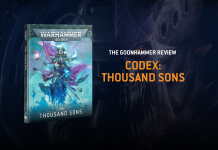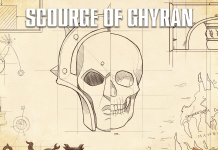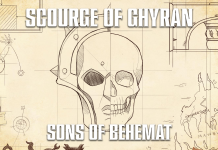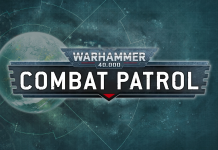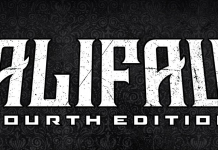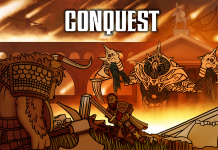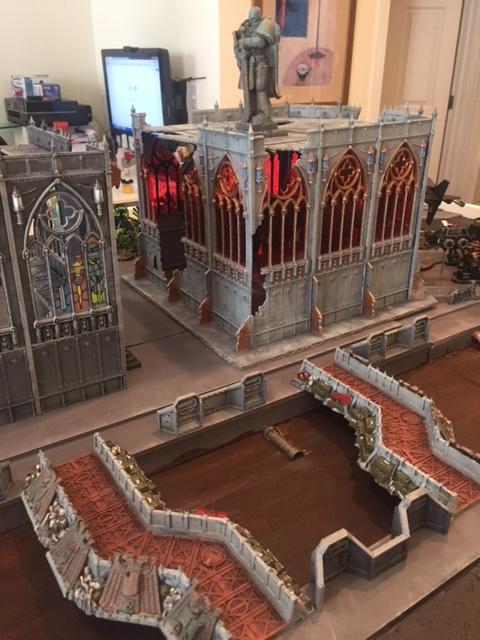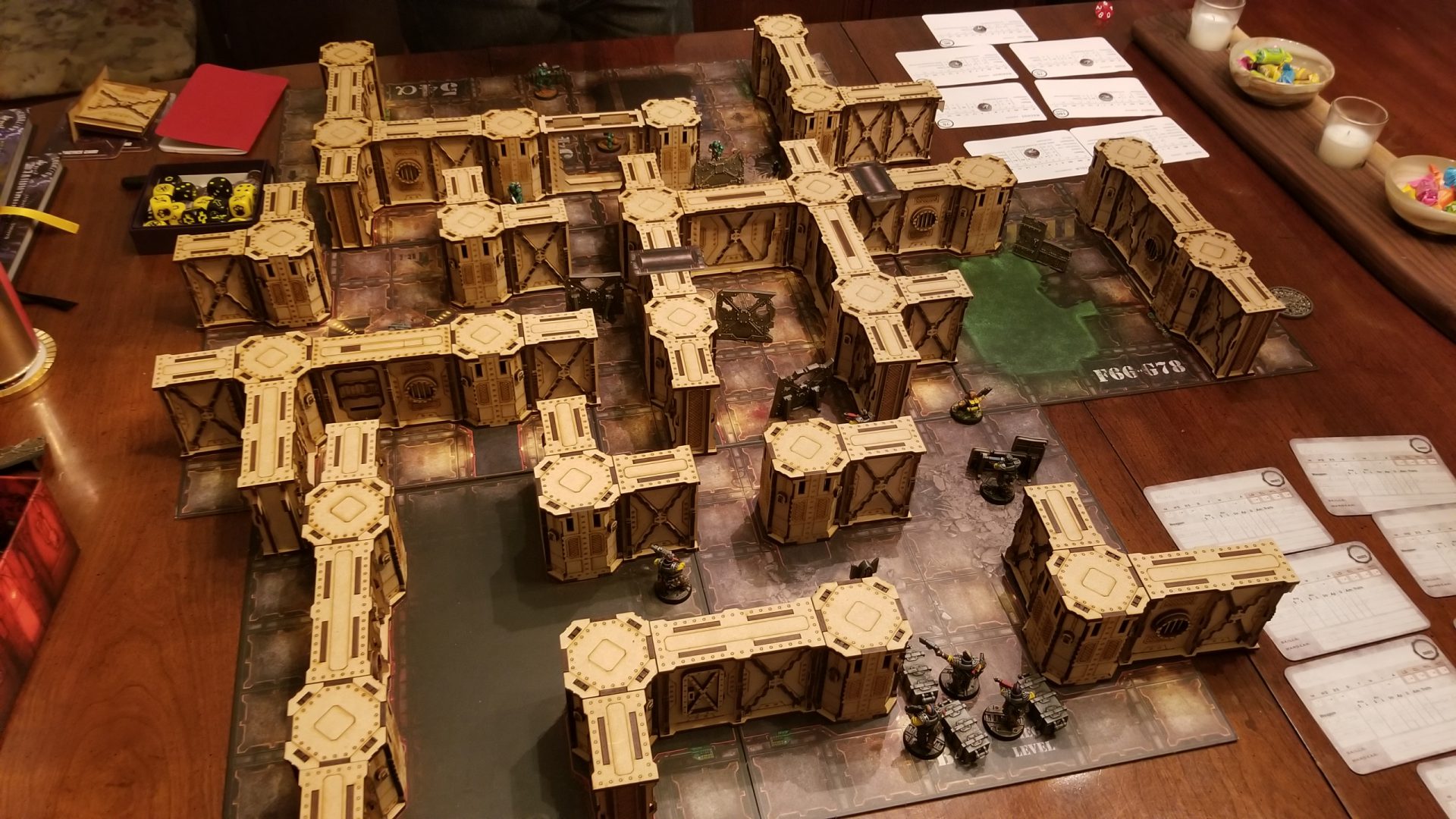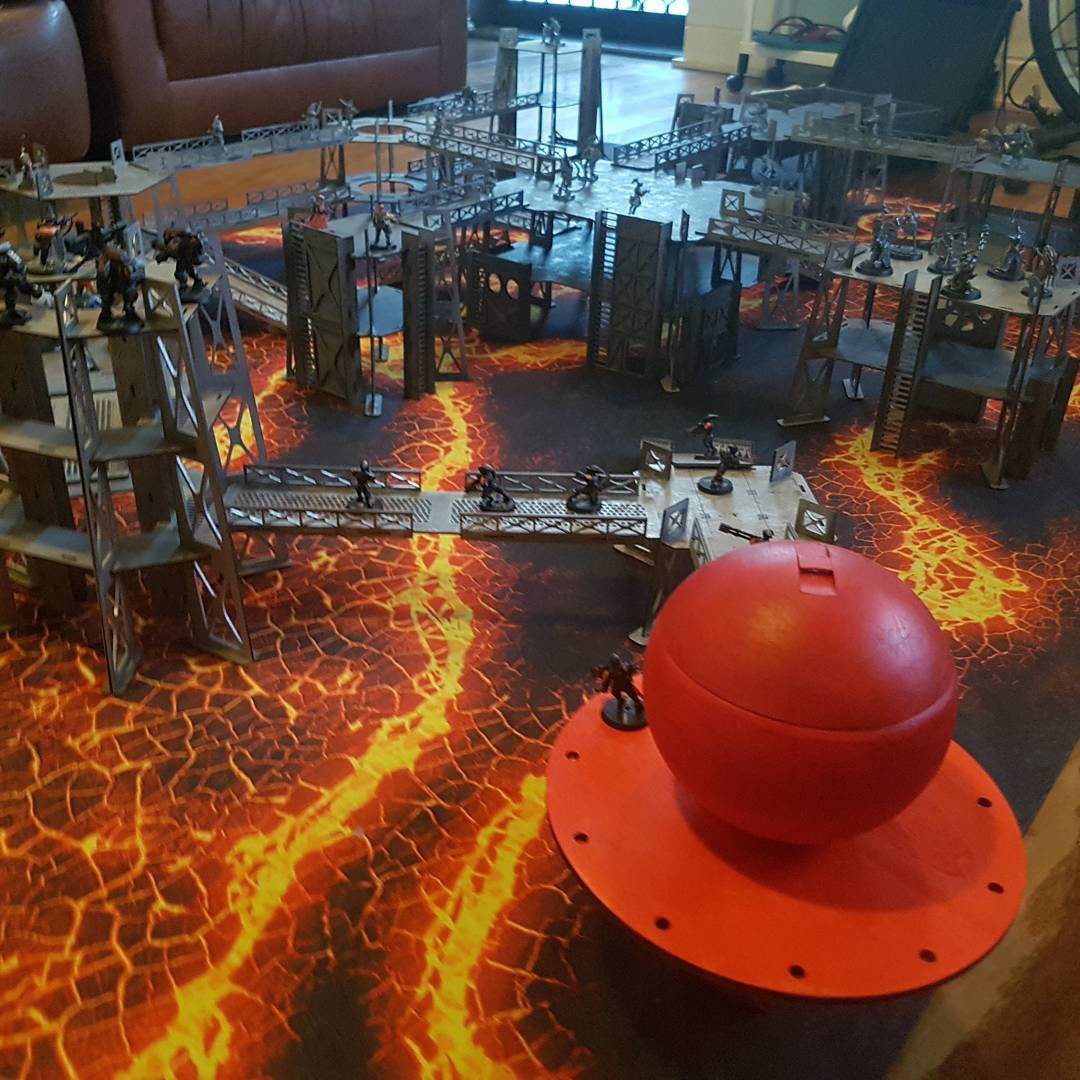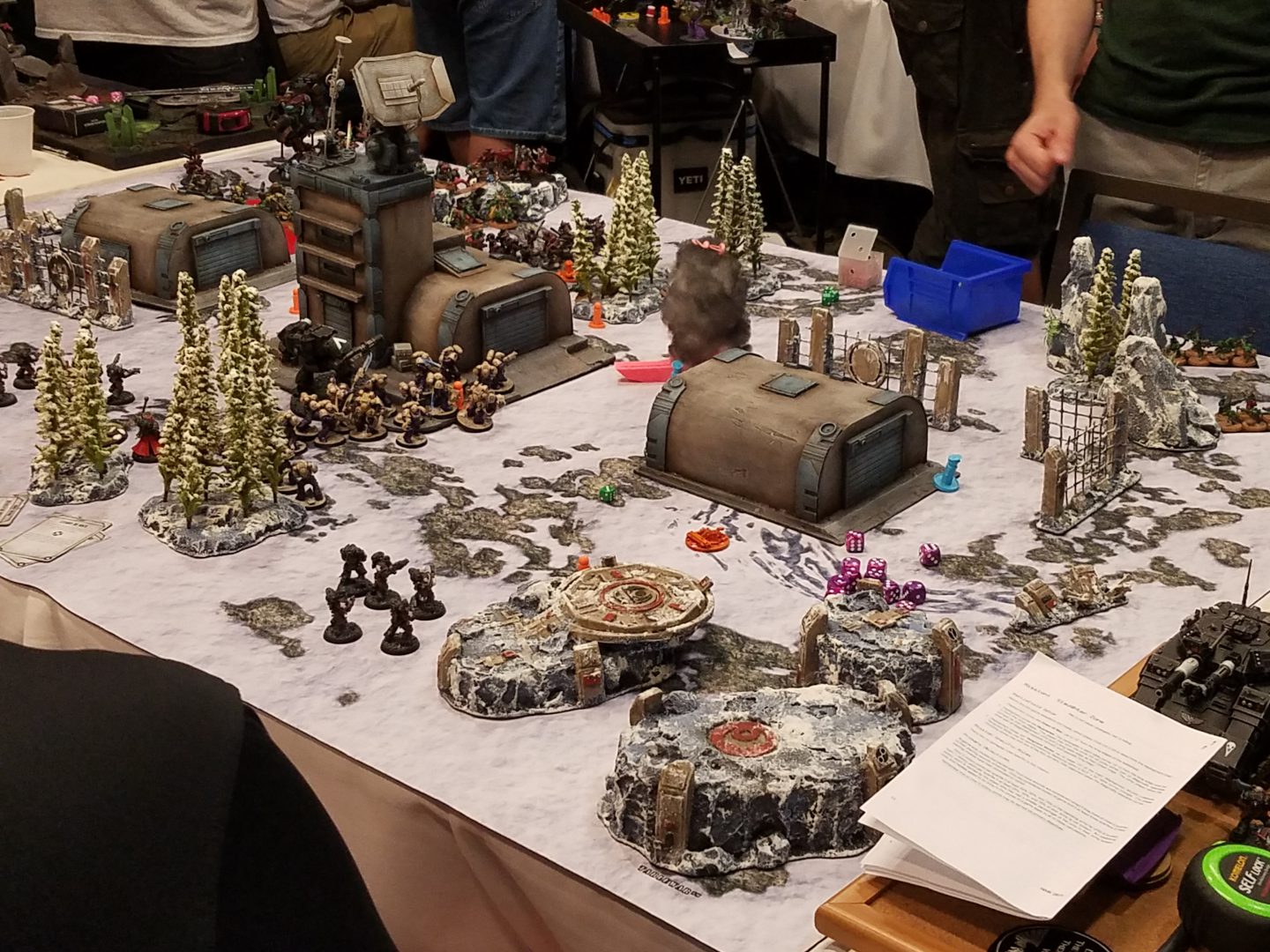The Warhammer 40,000 universe is a massive place, and the “Narrative Forge” hobby articles encourage thinking outside the box (literally) when putting models together and stretching yourself out in the hobby. They aim to make hobbyists and players comfortable growing beyond imitating the models they see in their Codexes and playing the rulebook missions, and serve as a source of inspiration for anyone wanting to forge new experiences in the hobby. This week, Robert “TheChirurgeon” Jones is continuing his multi-part series on creating and running campaigns. This week, he’s taking a break from different campaign types to discuss Battlezones and Killzones.
Massive armies meet in the ruins of a crumbling city. Titanic war machines clash as the planet breaks up all around them, lava spraying up from fissures in the planet’s crust. Hardened Kill Teams clash in the corridors of a massive spacecraft while a void battle rages all around them. The fiction and fluff of Warhammer 40k inspires fantastic thoughts about the battles in which its inhabitants engage, and the settings those battles take place in. It’s a shame then, that so many battles take place in the pedestrian confines of “Imperial Standard Battlefield 228A,” a bog-standard plain spotted with a series of ruins, sometimes shaped like giant Ls, with nothing special about the battlefield itself nor the conditions players play in. And look, I’m a big fan of NOVA terrain and having standardized, symmetrical layouts for battles. But I also love playing narrative battles on crazy battlefields that create shifting landscapes and require additional planning and tactics. That’s where Battlezones and Killzones come into play.
What’s a Battlezone?
Battlezones in Warhammer 40k, and Killzones in Kill Team, represent specific battlefields and conditions that have a significant impact on the battle itself, usually represented through custom rules. In that way, they go above and beyond just having a specific type of terrain or features — it’s the difference between having a bunch of buildings and ruins on your table and playing a Cities of Death game, with custom rules for things like breaching walls, firing from higher up, and climbing quickly with grappling hooks. When implemented well, Battlezones can add a whole new layer of strategy to the game or even transform it entirely. They’re a perfect fit for campaigns, where you may want to change up the landscapes and conditions of battles based on the campaign narrative.
Good Battlezones and Bad Battlezones
I know what you’re thinking: Battlezones sound cool as hell. And they are, for the most part. But not all of them. Like all mechanics, Battlezones can be good or bad, depending on how they’re worded but generally, it’s pretty easy to separate good battlezones from bad. While we’ll do some evaluation here, if you want to make your own battlezones or do your own evaluations (or some new ones come out), I’d posit that, for the most part, a good battlezone does the following:
- Has a significant impact on the game – it should be something that both players have to think about and deal with (or at least plan for) in most regular games
- Has semi-predictable effects – you can plan on some things happening, or at least predict the range of what’s possible
- Doesn’t create too much book keeping – Battlezones should make things more complicated without making them too complex; you should be able to remember all the rules you need to operate each turn
A battlezone that does those three things will usually be alright! Same goes for Killzones, though the rules for those tend to be pretty weak, but I’ll talk about what those do right. In contrast to this, bad Battlezones usually have lots of wacky random effects that force you to roll for what happens every turn, may not matter in games altogether, or may only affect one army, or have lots of complicated rules that bog things down or just end up being forgotten by the players.
The Battlezones of Warhammer 40,000
Alright, with that out of the way, let’s talk about the Battlezones available to Warhammer 40k players. I’m gonna break these up into three groups:
- The Great are Battlezones that are a blast to play. I think these totally embody what Battlezones can do, and are among the best examples of what they can be. You may not want to play with them every game, but they’re worth trying out at least once.
- The Good are Battlezones that have good execution, but one or two flaws that keep them from greatness. Still worth trying, but you may want to consider some tweaks, or only playing them with certain players or armies.
- The Bad are, at best, OK. They’re may be forgettable, or have mediocre rules, but they generally aren’t worth your time. If you do play them it might not be miserable, but you aren’t going to be left wanting more.
- The Ugly are just awful. The kind of bad that cause you to ask: “Who made these? Who is this for?” If you play these, you’re gonna have a bad time.
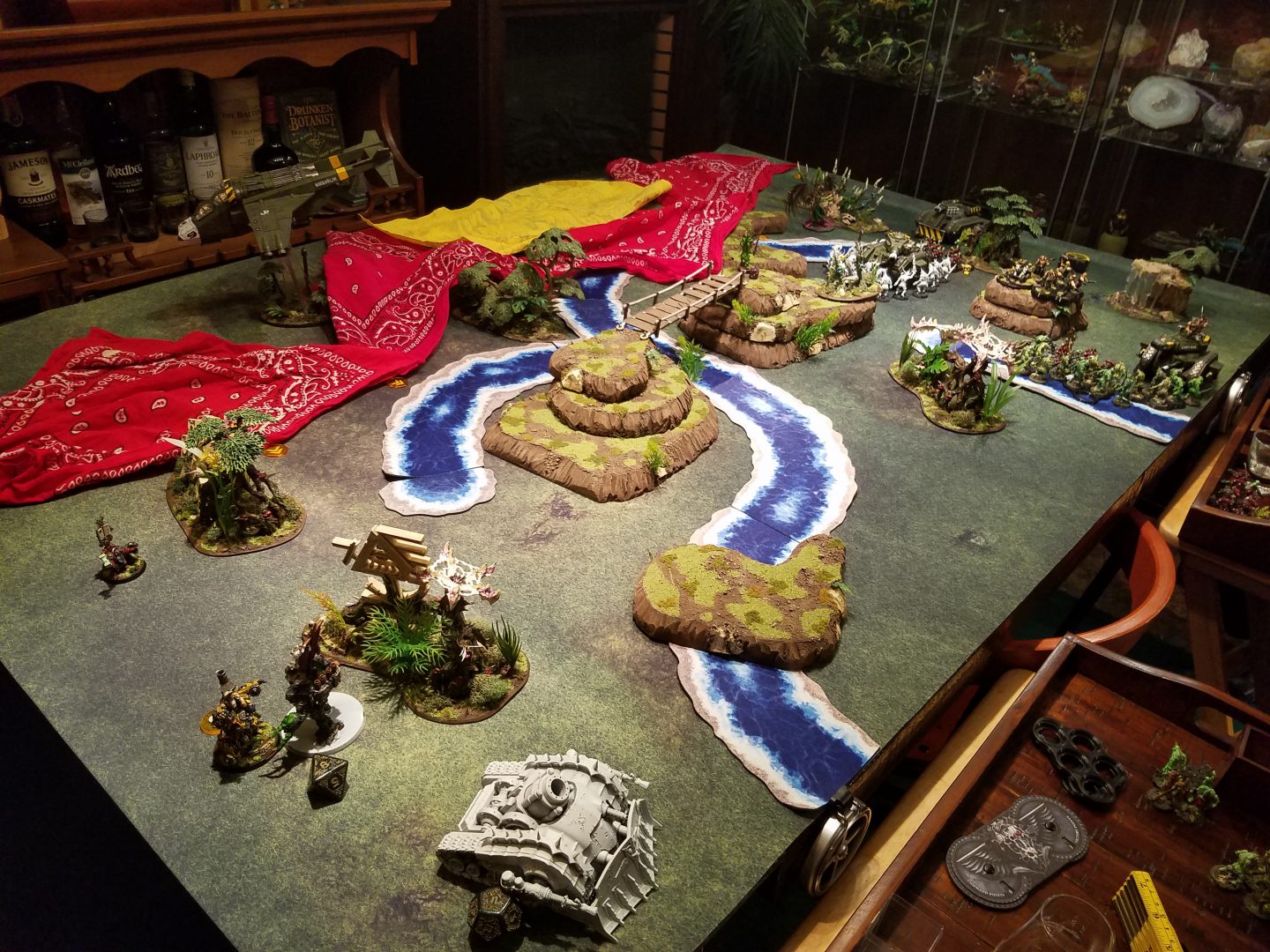
The Great
Geothermal Eruption
Located in: Vigilus Defiant Campaign Book
Lava from a nearby volcanic eruption is sweeping across the battlefield, engulfing everything in its path. Players use a series of counters to model the edge of the lava, and that moves at the start of each battle round, with players alternating moving the counters. It’s an extremely cool mission that works out very well visually and does exactly what you think it will do without being needlessly complex. I wish all battlezones were this cool.
Spirescape
Located in: Vigilus Defiant Campaign Book
The battle takes place on the tops of massive hives and skyscrapers, with only flying units able to travel between the dizzingly high peaks. Stratagems help Jump Pack units move across the battlefield and give flyers the ability to duck under the clouds and re-emerge elsewhere. It’s a very evocative setting, but one that will require proper battlefield planning and the right armies to make interesting. Still, it’s a cool concept and easy to adapt to other scenarios.
Speedwaaagh!
Located in: Vigilus Ablaze Campaign Supplement
Armies fight over wastelands while Ork raiders circle around and cut them off. It’s a really cool mission that has players rolling each turn to see if a line of Ork vehicles blow through the battlefield, guns blazing.
The Good
Cities of Death
Located in: Chapter Approved 2018, Urban Conquest Supplement
The Cities of Death rules create rules for fighting in urban centers, with crowded streets and ruined buildings. These rules completely transform 40k in a lot of ways, and most of them for the better — they add the Obscured (-1 to hit obscured targets) rule that shows up in Kill Team, Lucky Hit for mitigating that disadvantage (unmodified 6s always hit), rules for Streets and Roads, Dangerous Terrain, Shooting from above, and Hard and Soft cover. They also add nearly two dozen new stratagems to the game, which allow for everything from point-blank Overwatch fire to scaling buildings quickly with grappling hooks to damaging a building with demolitions charges. I really want to like the Cities of Death rules more than I do. The core of the rules are great – Adding the obscured and new cover rules really change things up in interesting ways and make the cover system in 40k much more rewarding to play with. On the other hand, the dozens of new stratagems bog things down substantially, making it clear that the designers couldn’t help but tack on every idea that came into their heads. It’s too much to keep track of, especially without printed stratagem cards. There’s also a new set of Maelstrom Tactical Objectives just for Cities of Death in the Urban Conquest book which are pretty good but again, lack cards, making them essentially worthless unless. So a lot of really great core rules make Cities of Death worth playing, but a lot of extra tacked-on complexity holds it back from greatness.
Urban Battlezone: Infested City
Located in: Chapter Approved 2018
In this battlezone, the city is infested with hostile mobs that will attack whoever gets close–these can be poxwalkers, genestealers, beasts, swarms, spore mines, or even lictors. The infestation rules are pretty neat, basically creating a third player of NPC mobs to deal with that randomly spawn, but are a known quantity in terms of what they can do and how they’ll act. That said, some of them are easier to deal with than others, and may be different levels of a challenging depending on your army. But this is a minor qualm.
Genestealer Infestation
Located in: Vigilus Defiant Campaign Supplement
Basically Infested City but only with Genestealers and you don’t have to be playing Cities of Death.
Irradiated Wasteland
Located in: Psychic Awakening III – Blood of Baal
A pretty straightforward set of rules for modeling a hellish, inhospitable landscape for infantry with some safe patches to stand on. The clouds of radiation are a neat touch, but aren’t just “hey roll to see if you take wounds out of nowhere” and create obstacles you may want to move around, but can still risk as needed.
Urban Battlezone: Conflagration
Located in: Chapter Approved 2018
In this battlezone, the city is on fire – buildings are ablaze and the inferno is spreading to nearby structures. Visibility is diminished by smoke, and units caught in burning buildings risk taking mortal wounds. Two unique stratagems allow players to either put out the fires on their buildings or set fires to make things worse. It’s another interesting scenario, but the level of book keeping can get ugly – you need to keep track of every single structure on the battlefield that’s on fire, and do the same for new ones as the fire spreads.
Spaceship
Located in: Vigilus Ablaze Campaign Supplement
Simulates battles taking place aboard a spaceship. These are kind of like a stripped-down version of Zone Mortalis rules, restricting you from taking flyers and dropping in units from orbit/high altitude, preventing shooting without line-of-sight, and having rolls of 1 to hit potentially hitting allies. The end result is very playable, if a bit forgettable. See below for an updated version of the more detailed Zone Mortalis rules for 8th edition.
The Bad
Deadly Storm
Located in: Vigilus Defiant Campaign Supplement
A powerful and deadly storm moves around the battlefield, occupying one 2×2′ square of the table at a time. It blocks line of sight and moves around randomly at the start of each battle round.
Urban Battlezone: Pollution
Located in: Chapter Approved 2018
In this battlezone, the city is covered in gross pollution – acid rain reduces the Toughness of units that aren’t in buildings, choking smog reduces the maximum range of Rapid Fire, Assault and Heavy weapons, and the crumbling structures become dangerous terrain for units crossing them. There’s a custom stratagem to fire at full range for 1 CP, but they only hit on 6s. I’d generally be on board for one or two of these conditions, and it’s great that they aren’t random, but all three together make things a nightmare for shooting armies, and those already find Cities of Death a less favorable environment. Applied to a non-Cities of Death game, they might fare a little better.
Field of Nightmares
Located in: Vigilus Defiant Campaign Supplement
Warp storms circle the battlefield, causing the Orks to feel a modicum of glee as their plans for Warhammer 40k fee right to me. This one’s like a slightly better Psychic Maelstrom, with more interesting results and mechanics.
High Altitude
Located in: Psychic Awakening I – Phoenix Rising
This one is like Spirescape, if you just had one big platform, removing the interesting mechanic where you have lots of impassible area for flyers to move on. Instead, the edges of the battlefield become dangerous as units can potentially fall off them or be blown off by harsh winds. An interesting concept but it needed more than just “stay away from the edge” as a mechanic.
Industrial Worlds
Located in: Chapter Approved 2017
Rules for playing in industrial settings. Or, more accurately, a set of stratagems for all the Sector Mechanicus terrain Games Workshop put out. Most of the stratagems aren’t even worth your time.
Night Fight
Located in: Warhammer 40,000 8th Edition Core Rulebook
The fight takes place at night, with low visibility reducing the effective range of ranged weapons, which incur penalties as the fire at targets more than 12″ away. Reserves may be delayed a turn, and Mysterious objectives make each objective a crapshoot. There’s also a custom stratagem to remove the penalty for firing at units more than 12″ away. This would probably fall into “good” if it just had the distance penalties but tacking on mysterious objectives doesn’t make a ton of sense and just adds another wacky random table. My advice: Ditch the Mysterious Objectives rule and this one is pretty playable, if favorable to melee armies. The Light ‘Em Up stratagem doesn’t scale thanks to being one-use, so this one works better for smaller games.
Perilous Cavern
Located in: Vigilus Ablaze Campaign Supplement
Similar to Spaceship, only without the rule for hitting friendly models and a random table to roll on every turn.
Raging Inferno
Located in: Vigilus Ablaze Campaign Supplement
Models a city completely on fire, like Conflagration. Unlike Conflagration, the fire starts at the top of buildings and works its way down. The fire spreading is more interesting and predictable, but the actual effect is not and the stratagems for Conflagration make that a superior battlezone choice.
Wasteland Dust Storm
Located in: Vigilus Defiant Campaign Book
The battlefield is a desert and deadly dust storms whip through, causing massive damage and blinding units. The rules for this one are relatively simple and the rules for the storm are intuitive, but the way the storm appears and expands is fairly lame.
Warp Tear
Located in: Psychic Awakening II – Faith and Fury
Another Warp Storm-like battlezone, with effects that can boost psykers while making failures more deadly, and units stand to be devoured by denizens of the warp. The rules for this are largely fine, but it’s just not very inspiring or evocative.
Warquake
Located in: Vigilus Defiant Campaign Supplement
In the camp of “very cool ideas with mediocre execution,” in this battlezone, distant war machines or mining equipment are causing faults to form in the battlefield, wreaking havoc along randomly-determined lines. The fault lines mechanic is very cool, but the effects table is lame, ending up being just another way to take mortal wounds.
The Ugly
Empyric Storms
Located in: Chapter Approved 2017
Rules for really chaotic battlefields with, again, more warp storms just swirling about. This is one of the worst battlezones in the game, with 36 random effects you can generate at the start of each turn, a bunch of which only matter for Daemons or Psykers. Go ahead and skip this one unless you’re playing Grey Knights vs. Daemons.
Fire and Fury
Located in: Warhammer 40,000 8th Edition Core Rulebook
The world is falling apart, with the ground splitting as debris falls from the sky. Basically, everything has to roll to take damage every turn as it moves, plus meteors batter the table. It’s conceptually not bad but it ends up just being a bunch of rolls to take mortal wounds every single turn.
Psychic Maelstrom
Located in: Warhammer 40,000 8th Edition Core Rulebook
Warp storms swirl all around, increasing psykers’ connection to the warp and causing widespread havoc. Psykers get +2 to their attempts and deny rolls, they can manifest additional powers, and if they perils, they roll on a separate table with different effects. I understand there’s only so much you can do with a scenario like this, but the fact that this one only matters to half the game’s armies and even then only if they take specific units means that it’s easy for one side to have no interactions with the rules while the other blows them up with mind bullets. Yeah, you can just not play it in those cases but I prefer battlezones that have broader appeal.
Maiden World
Located in: Psychic Awakening I: Phoenix Rising
Each turn, your roll to see if a single unit regains wound. Otherwise, when vehicles explode, a random Eldar character might flip out and get a bonus to its strength and attacks. It’s very possible to play a mission in this battlezone even with Eldar vs. Eldar, and never actually have its effects happen.
Tundric Blizzard
Located in: Vigilus Defiant Campaign Supplement
Snowstorms make things treacherous, obscuring visibility and slowing vehicles while dangerous predators may attack. This Battlezone has two random charts to roll on each turn, one of which you roll to see if you roll on it, and neither is very interesting.
Goonhammer Approved: Zone Mortalis for 8th Edition, v.2.0
Last year I made some custom Zone Mortalis rules for 8th edition that were pretty well-received. They acted as a direct port of the Horus Heresy rules, with custom detachments, stratagems, rules for doors and control, and rules for handling effects like void battles going on during a mission. I let those fall by the wayside as Chapter Approved 2019 approached because I was sure we’d be seeing some official Zone Mortalis rules following the release of the new Necromunda Dark Uprising boxed set with its plastic Zone Mortalis terrain, but Games Workshop appears to have dropped the ball there. So, as promised, I’ve updated my Zone Mortalis rules to accommodate a bunch of feedback I got from playtesters over the last year, and put them into a new, more printer-friendly package.
First, I’d like to thank the following playtesters and people who provided feedback:
- Greg “Greg” Chiasson
- Evan “Felime” Seifring
- BuffaloChicken
- Eric Chirlin
- Carl Tuttle of the Independent Characters
- Brian Berman
- Jack “BenBooley” Hunter
Change log
Anyways, here’s what’s changed in version 2.0 of the ZM rules:
- Updated some language to be more clear and corrected typos
- Updated Deep Strike rules to be more than 7″ away, but incoming models have to roll a D6 per model; on a roll of 1 a single model is lost to reflect the dangers of arriving in cramped quarters
- Updated Engineers list to include GSC Nexos
- Added the Combatant Detachment
- Clarified stratagems that allow reserves to enter from different locations to make it clear this happens at the end of a player’s Movement phase, preventing movement post-arrival
- Added the Obscured and Lucky Hit rules
- Added rules for taking a second detachment in larger games
- Changed the background on mission pages so they aren’t white text on black backgrounds
- Changed Catastrophic Damage to occur in each battle round after the first
- Changed Catastrophic Damage table to add current battle round to the result
Just Let Me Download the Rules Already
Ok fine. Here’s the link.
As always, if you play with these and have thoughts about them, I’d love to hear your feedback! Shoot me an email at contact@goonhammer.com or drop us a note in the comments below.

